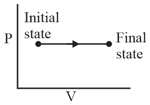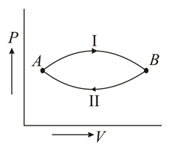EASY
NEET
IMPORTANT
Earn 100
The diagram for an ideal gas in a piston cylinder assembly undergoing a thermodynamic process is shown in the figure. The process is


(a)adiabatic
(b)isochoric
(c)isobaric
(d)isothermal
73.91% studentsanswered this correctly

Questions featured in Previous Year Papers on Heat & Thermodynamics
MEDIUM
NEET
IMPORTANT
Match Column - I and Column - II and choose the correct match from the given choices.
| Column - I | Column - II |
| (A) Root mean square speed of gas molecules | |
| (B) Pressure exerted by ideal gas | |
| (C) Average kinetic energy of a molecule | |
| (D) Total internal energy of of a diatomic gas |
MEDIUM
NEET
IMPORTANT
HARD
NEET
IMPORTANT
EASY
NEET
IMPORTANT
EASY
NEET
IMPORTANT
EASY
NEET
IMPORTANT
A gas at state changes to state through path and shown in figure. The change in internal energy is and , respectively. Then

HARD
NEET
IMPORTANT
HARD
NEET
IMPORTANT
